
Gin is a distilled alcoholic drink that derives its flavour from juniper berries and other botanical ingredients.
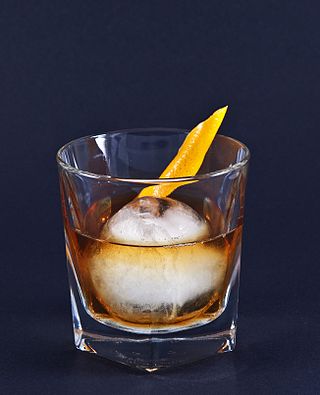
The old fashioned is a cocktail made by muddling sugar with bitters and water, adding whiskey, and garnishing with an orange slice or zest and a cocktail cherry. It is traditionally served with ice in an old fashioned glass.

A pub is a drinking establishment licensed to serve alcoholic drinks for consumption on the premises. The term first appeared in the late 17th century, to differentiate private houses from those open to the public as alehouses, taverns and inns. Today, there is no strict definition, but CAMRA states a pub has four characteristics:
- is open to the public without membership or residency
- serves draught beer or cider without requiring food be consumed
- has at least one indoor area not laid out for meals
- allows drinks to be bought at a bar
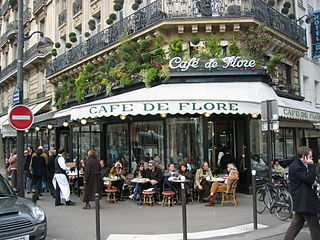
A coffeehouse, coffee shop, or café is an establishment that primarily serves various types of coffee, espresso, latte, and cappuccino. Some coffeehouses may serve cold drinks, such as iced coffee and iced tea, as well as other non-caffeinated beverages. A coffeehouse may also serve food, such as light snacks, sandwiches, muffins, fruit, or pastries. In continental Europe, some cafés also serve alcoholic beverages. Coffeehouses range from owner-operated small businesses to large multinational corporations. Some coffeehouse chains operate on a franchise business model, with numerous branches across various countries around the world.
The alcohol licensing laws of the United Kingdom regulate the sale and consumption of alcohol, with separate legislation for England, Wales, Northern Ireland and Scotland being passed, as necessary, by the UK parliament, the Senedd in Wales, the Northern Ireland Assembly, and the Scottish Parliament respectively.
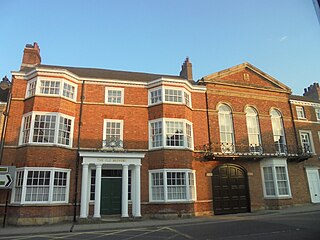
Samuel Smith Old Brewery, popularly known as Samuel Smith's or Sam Smith's, is an independent brewery and pub owner based in Tadcaster, North Yorkshire, England. It is Yorkshire's oldest brewery, founded in 1758, and one of three breweries in the town. Samuel Smith's, which is an unlimited family-owned company, produces a range including bitters, stouts, porters, lagers, and fruit beers, and is known as a highly traditional and somewhat eccentric operator of around 200 pubs due to its continued use of dray horses, bans on music and mobile devices, and low beer prices.
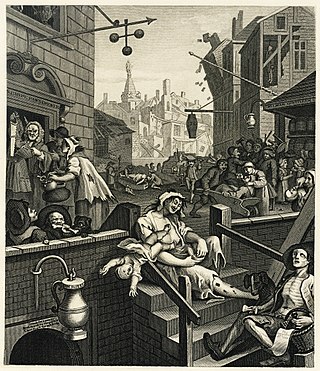
The Gin Craze was a period in the first half of the 18th century when the consumption of gin increased rapidly in Great Britain, especially in London. Daniel Defoe commented: "the Distillers have found out a way to hit the palate of the Poor, by their new fashion'd compound Waters called Geneva, so that the common People seem not to value the French-brandy as usual, and even not to desire it".
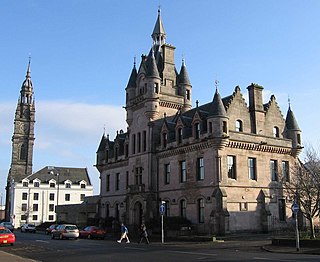
Scottish baronial or Scots baronial is an architectural style of 19th-century Gothic Revival which revived the forms and ornaments of historical architecture of Scotland in the Late Middle Ages and the Early Modern Period. Reminiscent of Scottish castles, buildings in the Scots baronial style are characterised by elaborate rooflines embellished with conical roofs, tourelles, and battlements with machicolations, often with an asymmetric plan. Popular during the fashion for Romanticism and the Picturesque, Scots baronial architecture was equivalent to the Jacobethan Revival of 19th-century England, and likewise revived the Late Gothic appearance of the fortified domestic architecture of the elites in the Late Middle Ages and the architecture of the Jacobean era.

A teahouse or tearoom is an establishment which primarily serves tea and other light refreshments. A tea room may be a room set aside in a hotel, especially for serving afternoon tea, or may be an establishment that only serves cream teas. Although the function of a tearoom may vary according to the circumstance or country, teahouses often serve as centers of social interaction, like coffeehouses.

An Australian pub or hotel is a public house or pub for short, in Australia, and is an establishment licensed to serve alcoholic drinks for consumption on the premises. They may also provide other services, such as entertainment, meals and basic accommodation.
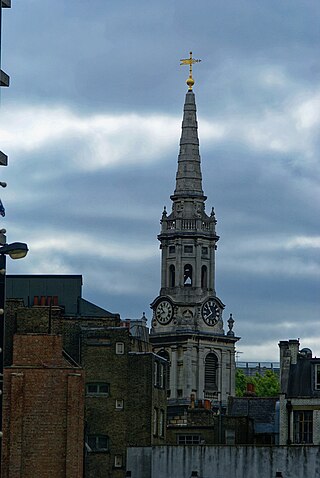
St Giles is an area in the West End of London in the London Borough of Camden. It gets its name from the parish church of St Giles in the Fields. The combined parishes of St Giles in the Fields and St George Bloomsbury were administered jointly for many centuries; leading to the conflation of the two, with much or all of St Giles usually taken to be a part of Bloomsbury. Points of interest include the church of St Giles in the Fields, Seven Dials, the Phoenix Garden, and St Giles Circus.

The Princess Louise is a public house situated on High Holborn, a street in central London. Built in 1872, it is best known for its well-preserved 1891 Victorian interior, with wood panelling and a series of booths around an island bar. It is a tied house owned by the Samuel Smith Brewery of Tadcaster, Yorkshire.
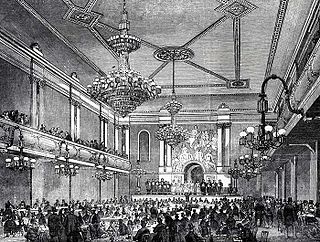
The Canterbury Music Hall was established in 1852 by Charles Morton on the site of a former skittle alley adjacent to the Canterbury Tavern at 143 Westminster Bridge Road, Lambeth. It was one of the first purpose-built music halls in London, and "probably the largest and grandest concert-room ever attached to a public house" in London. Morton came to be dubbed the Father of the Halls as hundreds of imitators were built within the next several years. The theatre was rebuilt three times, and the last theatre on the site was destroyed by bombing in 1942.

The Cittie of Yorke is a grade II listed public house on London's High Holborn, and is listed in CAMRA's National Inventory of Historic Pub Interiors. The pub is owned and operated by Samuel Smith's Old Brewery.

The Ten Bells is a public house at the corner of Commercial Street and Fournier Street in Spitalfields in the East End of London. It is sometimes noted for its supposed association with at least two victims of Jack the Ripper: Annie Chapman and Mary Jane Kelly.

In Ireland, a "pub" is an establishment licensed to serve alcoholic drinks for consumption on the premises. Irish pubs are characterised by a unique culture centred around a casual and friendly atmosphere, hearty food and drink, Irish sports, and traditional Irish music. Their widespread appeal has led to the Irish pub theme spreading around the world.

A drinking establishment is a business whose primary function is the serving of alcoholic beverages for consumption on the premises. Some establishments may also serve food, or have entertainment, but their main purpose is to serve alcoholic beverages. There are different types of drinking establishment ranging from seedy bars or nightclubs, sometimes termed "dive bars", to 5,000 seat beer halls and elegant places of entertainment for the elite. A public house, informally known as a "pub", is an establishment licensed to serve alcoholic drinks for consumption on the premises in countries and regions of British influence. Although the terms are increasingly used to refer to the same thing, there is a difference between pubs, bars, inns, taverns and lounges where alcohol is served commercially. A tavern or pot-house is, loosely, a place of business where people gather to drink alcoholic beverages and, more than likely, also be served food, though not licensed to put up guests. The word derives from the Latin taberna and the Greek ταβέρνα/taverna.

St Annes Pier is a Victorian era pleasure pier in the English seaside resort of St Annes-on-the-Sea, Lancashire. It lies on the estuary of the River Ribble. The pier, designed by Alfred Dowson, was completed in 1885 and was one of the earliest public buildings in St Annes, a 19th-century planned town. The pier was originally intended to be a sedate promenading venue for the resort's visitors, but attractions were later added. Changes made to the estuary channels to improve access to Preston Dock left the pier on dry land and ended its steamer services to Blackpool and Liverpool.
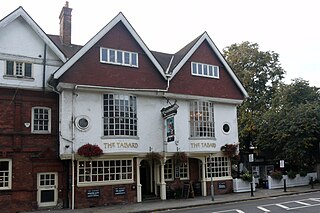
The block of three buildings containing The Tabard public house is a Grade II* listed structure in Chiswick, London. The block, with a row of seven gables in its roof, was designed by Norman Shaw in 1880 as part of the community focus of the Bedford Park garden suburb. The block contains the Bedford Park Stores, once a co-operative, and a house for the manager.
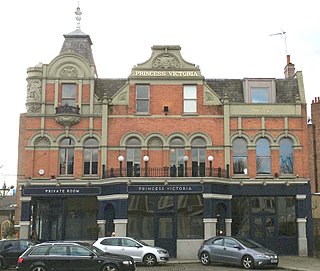
The Princess Victoria is a public house and former gin palace on the Uxbridge Road, Shepherd's Bush, London W12. First opened in 1829, it closed in June 2017 when its parent company, Affinity Bars and Restaurants, became insolvent, but re-opened in November 2017 under new operators Three Cheers Pub Company.



















